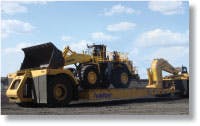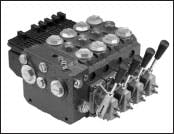Hooked on hydraulics
Edited by Alan L. Hitchcox, editor
When a huge mining excavator or loader has finished its work at one section of a large open pit mine, you don’t just drive it to the next location. Time is money, so operators can’t wait for equipment with a top speed of only a few miles an hour to travel any appreciable distance. Not only that, but driving this equipment long distances causes unnecessary wear to tracks and other key components. The equipment is so large that special, low-slung trailers, called lowboys, are used.
TowHaul Corp., Bozeman, Mont., designs and builds custom trailers that decrease costs and increase mobility in open pit mines around the world. In fact, TowHaul introduced the first modular lowboy trailer to the mining industry. Its patented equipment can be shipped to a mine site in sections and pinned together in a matter of days. This design has significantly reduced shipping expense and allows the lowboys to be delivered to hard-to-access sites.
A key feature of TowHaul’s lowboy is its removable gooseneck connection link. It has a patented hydraulic grab hook design that is fast and safe for demanding conditions of mine haulage, allowing hookup or unhooking within as few as 90 sec. TowHaul lowboys accommodate loads of 120 to 1600 tons, making them ideally suited for track dozers, blast hole drills, and other mining equipment.
The gooseneck is the most popular option of TowHaul’s patented towing package. In addition to mating with a lowboy trailer, the system can also be used to recover disabled trucks throughout a mine site without the need of support equipment. The towing option operates by lifting the entire front end of the disabled truck off the ground. This is accomplished with a sliding subframe, which is operated by in-cab controls. Lifting the front end of the truck eliminates the need for an operator to be in the cab of the disabled truck during towing.
Versatile hydraulics for control
Because of the huge loads involved, coupled with the need for safe, reliable operation, TowHaul designers specified hydraulics for actuating TowHaul lowboys’ operation. Key components used in the hydraulic system are discretely placed PVG 100 post-compensated valves from Sauer-Danfoss, Ames, Iowa.
PVG 100 is a hydraulic load sensing valve featuring load-independent flow control, whereby fluid flow to an individual function is independent of the load. Furthermore, flow to one function is independent of the load pressure of other functions. It also has an anti-saturation (flow sharing) feature, whereby if saturation occurs, pump flow will be shared between all functions, independent of load.
With post-compensated valves, work port flows depend on the pressure drop across the main spool. In open center systems, this pressure drop (standby-pressure) is generated by the pump flow back to tank across a pressure adjusting spool in the inlet. Because the pressure drop varies with pump flow back to tank, the work port flows do too. In closed center systems, the pressure drop across the main spool equals the standby setting of the pump, measured at the P port of the valve. The work port flows remain unchanged as long as the standby is unchanged.
TowHaul Corp. was among the first OEMs to start using the PVG 100 following its launch in 2005. “As soon as we started using them, we were very pleased with their function. They work so well in our application, that we use them on all our units,” says Matt Crawford, Systems Design Manager at TowHaul.
Mike Henson, of Berendsen Fluid Power, a Sauer-Danfoss distributor, introduced the PVG 100 to TowHaul in response to a request for an electrically actuated valve. The aim was to replace an existing mechanically actuated valve on TowHaul’s removable gooseneck. “For TowHaul, speed is not of the essence — controllability is,” says Henson.
Multi-functional capability
The PVG 100 supplies hydraulic oil for all the gooseneck functions, each requiring 55 to 60 gpm of flow. Electrical actuation of the valve fits well with the modern mining industry’s move towards more electronic functions. “The electric actuator makes the valve much cleaner, less cumbersome, and easier to install than our previous mechanically actuated valve. The DIN electric connectors are really handy, as wires can be quickly reconnected if they are damaged in the mine,” says Crawford. “We also like the mechanical stroke limiters. Even though we only use the valve’s on-off function, instead of its full load-sensing ability, the limiters make it possible to reduce the amount of flow so it matches the application’s requirements.”
TowHaul uses the PVG 100 as a three- to six-function valve, depending on whether the gooseneck controls a non-towing or towing unit. For non-towing purposes, the unit serves as a hitch assembly that connects a truck to a lowboy. Its three valve functions here include the apron (up and down positioning of the hitch), the grab hook mechanism (which positions the hitch on the lowboy pickup shaft), and the toe that raises the lowboy for transport.
For towing units, a fourth function is necessary to slide the hitch into a rigid position for connection to a disabled truck that can then be safely towed. Optional valve functions are also available, such as TowHaul’s patented park brake release system, which allows the tow truck operator to release the brakes of the disabled haul truck. With the help of the PVG 100 valve, the system is able to maintain a constant oil pressure, preventing the brakes from reapplying while towing is underway.
New prototype
More new developments are on the way. At present, TowHaul is collaborating with a hydraulic supplier on a valve design for a higher-tonnage unit with four cylinders. To accommodate the extremely high flow needs, a hybrid valve is being tested, comprising a PVG 100 valve bolted onto a hydraulic integrated circuit block.
For more information, visit www.sauer-danfoss.com.




